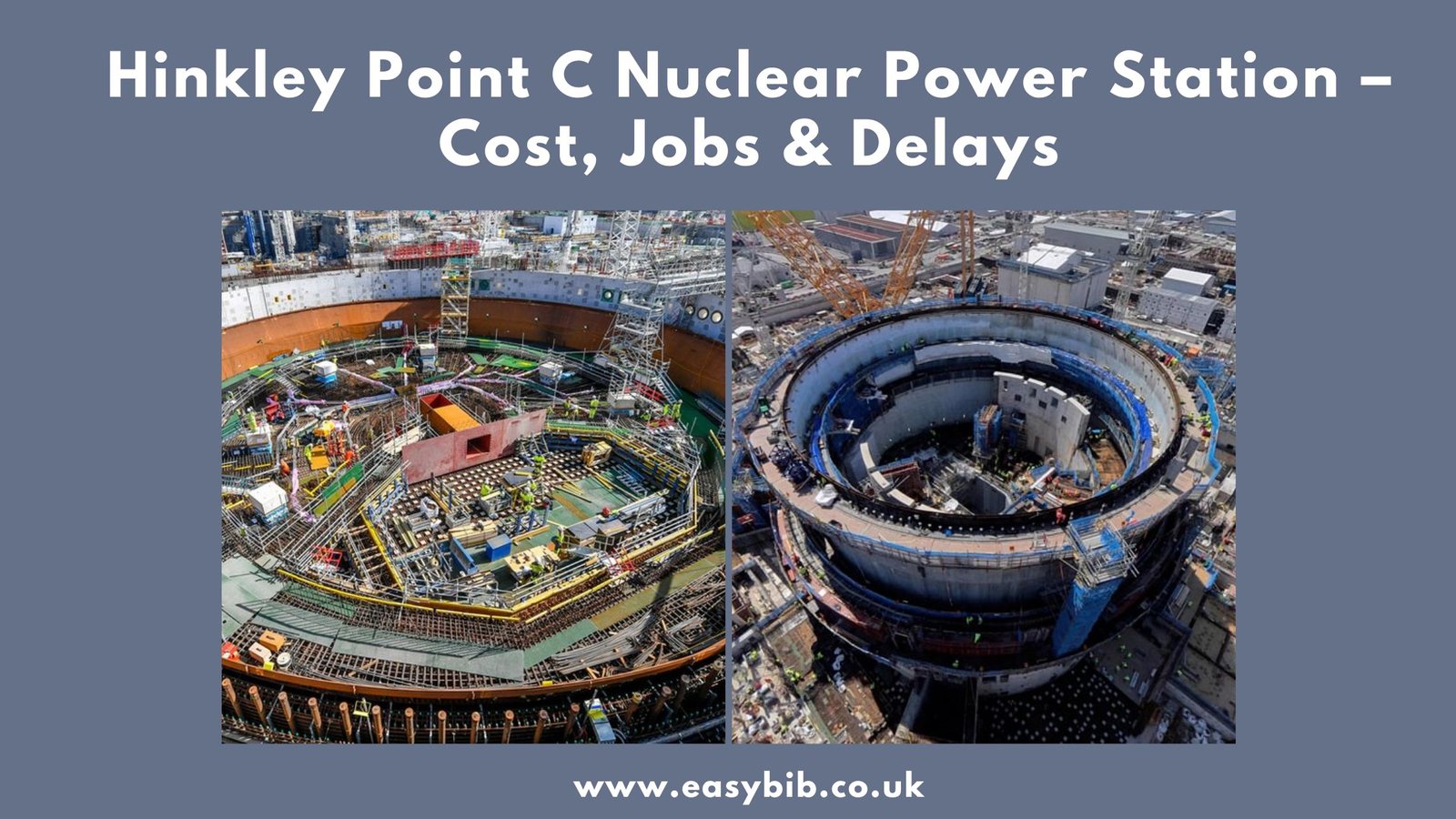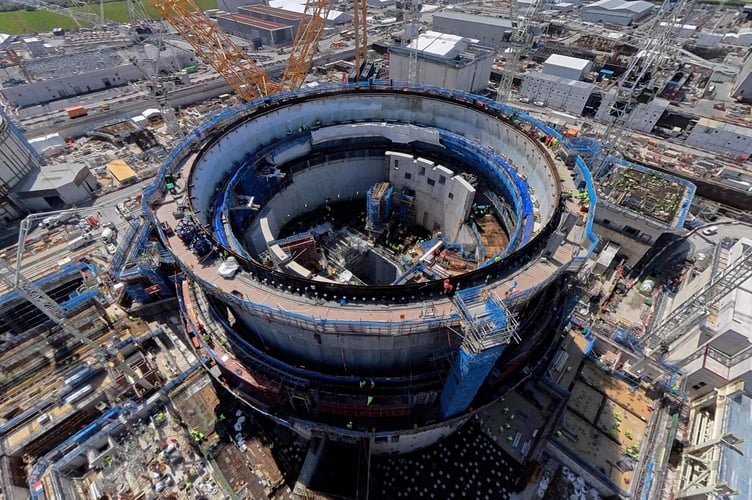Hinkley Point C Nuclear Power Station – Cost, Jobs & Delays

Hinkley Point C stands as one of the most ambitious energy projects in modern Britain. Located in Somerset, near Bridgwater, this nuclear power station aims to produce reliable and low-carbon electricity for millions of homes. It is the first new nuclear power plant in the UK for more than two decades. The project promises to deliver cleaner energy and support national goals for reducing carbon emissions.
Location and Background
Hinkley Point C sits on the Bristol Channel coast in Somerset, England. The site already hosts two older stations, Hinkley Point A and B, which are now shut down or being decommissioned. The new station continues a long tradition of nuclear power generation in this region. Its location was chosen due to access to cooling water and existing grid connections.
The project began after years of studies, approvals, and public consultations. EDF Energy, a French energy company, leads the construction and operation. China General Nuclear Power Group (CGN) also holds a significant stake. The plan is to build two European Pressurised Reactors (EPRs), each capable of producing over 1,600 megawatts of electricity.
Design and Construction
Modern Engineering and Safety
Each of the two EPR units at Hinkley Point C uses pressurised water reactor technology. This design is known for high efficiency and advanced safety systems. The reactors are built within large reinforced concrete structures designed to withstand extreme events. Modern control systems and multiple backup safety mechanisms are also part of the design.
Cooling and Infrastructure
The station will use seawater from the Bristol Channel for cooling. Massive tunnels, each several kilometres long, have been built beneath the seabed to draw in and return the water. The infrastructure also includes a marine jetty, cooling towers, and new substations. These will connect the power station to the national grid through the Hinkley Connection Project.
Progress and Milestones
Construction officially began in December 2018 after several years of planning. Early work focused on site preparation and foundation pouring. The large circular bases for both reactor units were completed by 2020. Since then, heavy components like the reactor pressure vessel and steam generators have been installed. A massive crane named Big Carl, one of the largest in the world, has been used for lifting the heaviest modules.
Cost and Financing
Rising Project Costs
When first announced, Hinkley Point C was expected to cost around £18 billion. Over the years, costs have risen due to inflation, delays, and material expenses. EDF now estimates the total cost to be between £31 and £34 billion, based on 2015 prices. Adjusted for inflation, that figure is much higher today.
Funding and Ownership
EDF Energy holds about two-thirds of the project, while CGN owns roughly one-third. The UK government provided financial guarantees but does not directly fund the construction. This structure means that investors, not taxpayers, carry most of the financial risk. However, long-term agreements will allow EDF to sell electricity at a fixed price once the plant starts generating.
Economic Benefits
Hinkley Point C supports Britain’s energy security and aims to reduce dependence on fossil fuels. When both reactors are operational, they will provide around 7% of the UK’s electricity demand. This contribution will help the country achieve net-zero carbon emissions by 2050.
Employment and Skills
The project has created thousands of jobs during construction. At peak times, over 10,000 people have worked on-site. Around 25,000 job opportunities are expected over the lifetime of the project, including indirect employment through the supply chain. Roles range from civil engineers and electricians to welders and crane operators.
EDF has established training centres to develop technical skills among workers. Apprenticeships in welding, electrical work, and mechanical maintenance are available for young professionals. These programs ensure that the workforce gains valuable experience in nuclear engineering. The investment in skills will also benefit future nuclear projects in the UK.
Worker Strikes and Protests
Despite progress, the project has faced worker unrest. In mid-2025, hundreds of mechanical engineers went on an unofficial strike. They protested against management behaviour and working conditions. The strike drew national attention and led to temporary disruptions on-site.
Management responded by investigating the allegations and adjusting team structures. Work resumed shortly after, but the incident highlighted the pressures of large-scale construction projects. EDF has since worked with trade unions to improve communication and safety standards.
Crane Pin Failure and Safety Concerns

In 2025, a technical issue was reported involving a crane pin failure at the construction site. Cracks were found in part of a crane mast during an inspection. Fortunately, no one was injured, and operations were halted immediately for safety checks. The event was reported under official UK safety regulations.
Safety remains a priority at Hinkley Point C. The scale of construction means constant maintenance and inspections are necessary. The incident reminded everyone of the importance of safety in such a complex and high-risk environment.
Timeline and Completion Date
When plans were approved, the first reactor was expected to be completed by 2025. However, a combination of factors has caused several delays. The COVID-19 pandemic, supply chain disruptions, and technical challenges all affected progress.
EDF now predicts that Unit 1 will begin operation between 2029 and 2031. Unit 2 will follow about a year later. Each delay adds pressure on the project’s budget, but EDF continues to emphasize long-term benefits. The company maintains that once operational, the station will deliver clean energy for at least 60 years.
Environmental Impact
Environmental groups have raised concerns about the impact of seawater cooling on marine life. The Bristol Channel is home to many fish species, and campaigners fear that intake systems could harm them. EDF has introduced fish protection measures, including low-velocity intake heads and return systems to reduce harm.
The project also promotes sustainability in other areas. Recycling and reuse of construction materials are encouraged. Biodiversity plans include restoring habitats around the site after completion. These measures aim to balance energy needs with environmental protection.
Conclusion
Hinkley Point C represents a cornerstone of Britain’s energy transition. When completed, it will provide steady, low-carbon power for millions of homes. Despite its difficulties, the project has advanced nuclear expertise and created thousands of jobs. It also serves as a model for future plants like Sizewell C in Suffolk.
The road to completion may be long, but the outcome promises lasting value. Hinkley Point C will stand as a symbol of engineering achievement and a major step toward a cleaner energy future.
